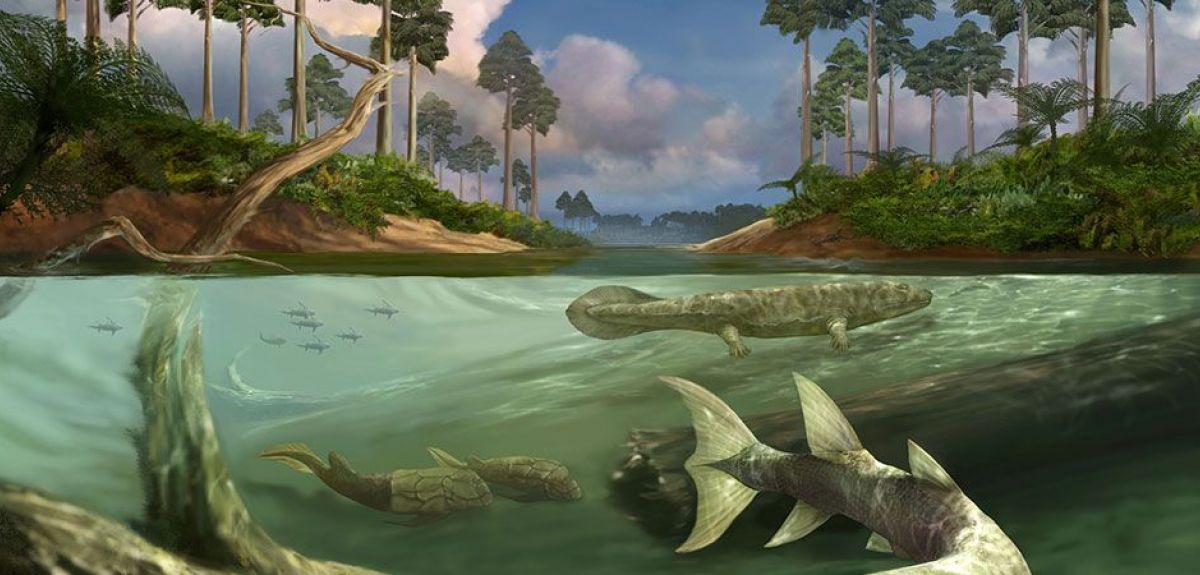
Credit: The Field Museum of Natural History in Chicago
Large tides may have been a key factor in the evolution of bony fish and tetrapods
Pioneering research, published in Proceedings of the Royal Society A, into ancient tides during the Late Silurian - Devonian periods (420 million years ago - 380 million years ago), suggests that large tides may have been a key environmental factor in the evolution of bony fish and early tetrapods, the first vertebrate land-dwellers.
The study is a detailed development of a theory previously published in the same journal, which suggested that the Moon’s particular mass and orbital location are optimised for creating large tidal ranges and isolating tidal pools, which in turn may have been a biological impetus for the development of limbs in fish stranded between very high tides.
First detailed numerical simulations
Researchers from Bangor University and Oxford University in the UK and Uppsala University in Sweden have been the first to produce detailed numerical simulations to address the question of whether large tides occurred during this critical period. These are also the first calculations to relate tidal hydrodynamics to an evolutionary biological event.
The numerical simulations were computed using palaeogeographic reconstructions of the Earth’s continents in an established state-of-the-art numerical tidal model
The numerical simulations were computed using palaeogeographic reconstructions of the Earth’s continents in an established state-of-the-art numerical tidal model. The simulation results show tidal variations in excess of four meters occurring around an area known as the South China block, which is the site of the origin and diversification of the earliest bony fish group, and has produced the earliest important fossils for this group. Geological evidence also points to tidal environments being closely associated with this class of fossils.
These first-of-their-kind results stimulate the need for more detailed tidal simulations of the ancient Earth. In particular, the researchers believe that the method used in this study can be used with a variety of palaeogeographic reconstructions at other time periods, to explore the tidal influence upon the origin and diversification of other early vertebrates, and perhaps the opposite as well: what might have been the role of tides in precipitating marine extinction events?
Read the full paper, 'A key environmental driver of osteichthyan evolution and the fish-tetrapod transition', Proceedings of the Royal Society A.
Image caption: This is the Devonian Mural from the Field Museum of Natural History in Chicago, one of the leading museums of its kind in the world. It depicts a land/seascape from the late Devonian period, roughly when land vertebrates first appeared, perhaps 380 million years ago. It shows, with careful accuracy, some of the flora and shallow-sea fauna typical of that period. Early tetrapods, such as the specimen seen near the water’s surface, are the ancestors of reptiles and may have been stranded in extensive networks of tidal pools in regions of unusually high tides, and evolved critical land navigation skills in response. Recent mathematical calculations of the ocean tides of ancient Earth carried out by researchers at Oxford, Bangor, and Uppsala Universities, the first of their kind, lend support to this scenario.
Image Karen Carr © The Field Museum
 Oxford launches first human aerosol TB challenge trial
Oxford launches first human aerosol TB challenge trial
 Rees Centre report reveals challenges faced by Black and Asian kinship carers
Rees Centre report reveals challenges faced by Black and Asian kinship carers
 Expert Comment: The Modern Slavery Act at 10 – what have we learnt for human rights?
Expert Comment: The Modern Slavery Act at 10 – what have we learnt for human rights?